Cisco Systems CP7945G User Manual

Cisco Unified IP Phone User Guide for Cisco Unified Communications Manager 8.5(1) (SCCP and SIP)
For Cisco Unified IP Phone 7975G, 7971G-GE, 7970G, 7965G, and 7945G
Americas Headquarters
Cisco Systems, Inc. 170 West Tasman Drive
San Jose, CA 95134-1706 USA http://www.cisco.com Tel: 408 526-4000
800 553-NETS (6387) Fax: 408 527-0883

Contents
Getting Started 1
Using this Guide 1
Finding Additional Information 2
Accessing Cisco Unified IP Phone 7900 Series eLearning Tutorials 2
Safety and Performance Information 2
Cisco Product Security Overview 3
Accessibility Features 4
Connecting Your Phone 5
An Overview of Your Phone 9
Understanding Buttons and Hardware 9
Understanding Lines and Calls |
14 |
|
|
|
|
|
Understanding Line and Call Icons |
15 |
|
|
|||
Understanding Phone Screen Features |
16 |
|
|
|||
Choosing Phone Screen Items |
17 |
|
|
|
||
Cleaning and Maintaining the Phone Screen |
17 |
|
||||
Understanding Feature Buttons and Menus 18 |
|
|
||||
Accessing the Help System on Your Phone |
19 |
|
||||
Understanding Feature Availability |
19 |
|
|
|
||
Understanding SIP vs. SCCP 20 |
|
|
|
|
|
|
Basic Call Handling |
21 |
|
|
|
|
|
Placing a Call—Basic Options |
21 |
|
|
|
|
|
Placing a Call—Additional Options |
22 |
|
|
|
||
Answering a Call 24 |
|
|
|
|
|
|
Ending a Call 26 |
|
|
|
|
|
|
Using Hold and Resume |
26 |
|
|
|
|
|
Cisco Unified IP Phone Guide for Cisco Unified Communications Manager 8.5(1) (SCCP and SIP) |
iii |
|||||
Using Mute 27
Switching Between Multiple Calls 28
Switching an In-Progress Call to Another Phone 28
Viewing Multiple Calls |
29 |
|
|
|
|
|
||
Transferring Calls |
30 |
|
|
|
|
|
|
|
Sending a Call to a Voice Message System |
31 |
|||||||
Forwarding Calls to Another Number |
31 |
|
||||||
Using Do Not Disturb |
33 |
|
|
|
|
|
||
Making Conference Calls |
33 |
|
|
|
|
|||
Using Conference Features |
34 |
|
|
|||||
Using Conference |
34 |
|
|
|
|
|||
Using Join |
35 |
|
|
|
|
|
|
|
Using cBarge |
36 |
|
|
|
|
|
|
|
Using Meet-Me |
36 |
|
|
|
|
|||
Viewing or Removing Conference Participants 37 |
||||||||
Placing or Receiving Intercom Calls |
37 |
|
||||||
Advanced Call Handling |
39 |
|
|
|
||||
Speed Dialing 39 |
|
|
|
|
|
|
|
|
Picking Up a Redirected Call on Your Phone |
40 |
|||||||
Storing and Retrieving Parked Calls |
41 |
|
||||||
Logging Out of Hunt Groups |
42 |
|
|
|
||||
Using a Shared Line |
43 |
|
|
|
|
|
|
|
Understanding Shared Lines |
43 |
|
|
|||||
Using Barge to Add Yourself to a Shared-Line Call 43 |
||||||||
Understanding Barge Features 44 |
|
|||||||
Using Barge Features |
44 |
|
|
|||||
Preventing Others from Viewing or Barging a Shared-Line Call 45 |
||||||||
Using BLF to Determine a Line State |
46 |
|
||||||
Making and Receiving Secure Calls 47
Tracing Suspicious Calls 49
Prioritizing Critical Calls 49
Using Cisco Extension Mobility 50
iv |
OL-22332-01 |
Managing Business Calls Using a Single Phone Number 52
Using a Handset, Headset, and Speakerphone |
55 |
||||
Using a Handset |
55 |
|
|
|
|
Using a Headset |
55 |
|
|
|
|
Using a Speakerphone 56 |
|
|
|
|
|
Using AutoAnswer with a Headset or Speakerphone |
57 |
||||
Changing Phone Settings |
59 |
|
|
|
|
Customizing Rings and Message Indicators |
59 |
|
|||
Customizing the Phone Screen |
60 |
|
|
|
|
Using Call Logs and Directories 63 |
|
|
|
||
Using Call Logs |
63 |
|
|
|
|
Directory Dialing |
65 |
|
|
|
|
Using Corporate Directory on Your Phone |
66 |
|
|||
Using Personal Directory on Your Phone |
66 |
|
|||
Accessing Voice Messages 69 |
|
|
|
||
Using the User Options Web Pages 71 |
|
|
|||
Accessing Your User Options Web Pages |
71 |
|
|
||
Configuring Features and Services on the Web 72 |
|
||||
Using the Personal Directory on the Web |
72 |
|
|||
Using Your Personal Address Book on the Web 72 |
|||||
Configuring Fast Dials on the Web |
73 |
|
|||
Using the Address Book Synchronization Tool |
74 |
||||
Setting Up Speed Dials on the Web 74 |
|
|
|||
Setting Up Phone Services on the Web |
75 |
|
|||
Controlling User Settings on the Web |
77 |
|
|||
Controlling Line Settings on the Web |
77 |
|
|
||
Setting Up Phones and Access Lists for Mobile Connect 79
Using Cisco WebDialer 81
Cisco Unified IP Phone Guide for Cisco Unified Communications Manager 8.5(1) (SCCP and SIP) |
v |
Understanding Additional Configuration Options 83
Troubleshooting Your Phone 85
General Troubleshooting 85
Viewing Phone Administration Data 86
Using the Quality Reporting Tool 87
Cisco One-Year Limited Hardware Warranty Terms 89
Index 91
vi |
OL-22332-01 |

Getting Started
Using this Guide
This guide provides you with an overview of the features available on your phone. You can read it completely for a solid understanding of your phone’s capabilities or refer to the table below for pointers to commonly used sections.
If you want to... |
Then... |
|
|
Explore your phone on your own |
Press ? on the phone when you need assistance. |
Review safety information |
See Safety and Performance Information, page 2. |
|
|
Connect your phone |
See Connecting Your Phone, page 5. |
|
|
Use your phone after it is installed |
Start with An Overview of Your Phone, page 9. |
|
|
Learn what the button lights mean |
See Understanding Buttons and Hardware, page 9. |
|
|
Learn about the phone screen |
See Understanding Phone Screen Features, page 16. |
|
|
Make calls |
See Placing a Call—Basic Options, page 21. |
|
|
Put calls on hold |
See Using Hold and Resume, page 26. |
|
|
Mute calls |
See Using Mute, page 27. |
|
|
Transfer calls |
See Transferring Calls, page 30. |
|
|
Make conference calls |
See Making Conference Calls, page 33. |
|
|
Set up speed dialing |
See Speed Dialing, page 39. |
|
|
Share a phone number |
See Using a Shared Line, page 43. |
|
|
Use your phone as a speakerphone |
See Using a Handset, Headset, and Speakerphone, page 55. |
|
|
Change the ring volume or tone |
See Changing Phone Settings, page 59. |
|
|
View your missed calls |
See Using Call Logs, page 63. |
|
|
Listen to your voice messages |
See Accessing Voice Messages, page 69. |
|
|
See softkey and icon definitions |
Refer to the Quick Reference Card in the front of this guide. |
|
|
Cisco Unified IP Phone Guide for Cisco Unified Communications Manager 8.5(1) (SCCP and SIP) |
1 |

Finding Additional Information
•You can access the most current Cisco Unified IP Phone documentation on the World Wide Web at this URL:
http://www.cisco.com/en/US/products/hw/phones/ps379/products_user_guide_list.html
•You can access the Cisco website at this URL: http://www.cisco.com/
•You can access the most current Licensing Information at this URL:
http://www.cisco.com/en/US/docs/voice_ip_comm/cuipph/all_models/openssl_license/7900_ssllic. html
•Cisco international websites:
Allows access to international Cisco websites from www.cisco.com by clicking on the Worldwide [change] link at the top of the web page.
Accessing Cisco Unified IP Phone 7900 Series
eLearning Tutorials
(SCCP phones only)
The Cisco Unified IP Phone 7900 Series eLearning tutorials use audio and animation to demonstrate basic calling features. You can access eLearning tutorials online (for several phones) from your personal computer. Look for the eLearning tutorial (English only) for your phone in the documentation list at the following location:
http://www.cisco.com/en/US/products/hw/phones/ps379/products_user_guide_list.html
Note Although an eLearning tutorial may not be available for your specific Cisco Unified IP Phone, refer to the Cisco Unified IP Phone 7900 Series eLearning tutorials for an overview of common IP phone features and functionality.
Safety and Performance Information
Refer to these sections for information about the impact of power outages and other devices on your Cisco Unified IP Phone.
2 |
OL-22332-01 |

Getting Started
Power Outage
Your accessibility to emergency service through the phone is dependent on the phone being powered. If there is an interruption in the power supply, Service and Emergency Calling Service dialing will not function until power is restored. In the case of a power failure or disruption, you may need to reset or reconfigure equipment before using the Service or Emergency Calling Service dialing.
Using External Devices
When you use external devices with the Cisco Unified IP Phone, Cisco recommends the use of good-quality external devices, such as headsets, that are shielded against unwanted radio-frequency (RF) and audio -requency (AF) signals.
Depending on the quality of these devices and their proximity to other devices, such as mobile phones or two-way radios, some audio noise may still occur. In these cases, Cisco recommends that you take one or more of these actions:
•Move the external device and its cables away from the source of the RF or AF signals.
•Use shielded cables for the external device, or use cables with a better shield and connector.
•Shorten the length of the external device cable.
•Apply ferrites or other such devices on the cables for the external device.
Cisco cannot guarantee the performance of the system because Cisco has no control over the quality of external devices, cables, and connectors. The system will perform adequately when suitable devices are attached using good quality cables and connectors.
Caution In European Union countries, use only external speakers, microphones, and headsets that are fully compliant with the EMC Directive (89/336/EC).
Cisco Product Security Overview
This product contains cryptographic features and is subject to United States and local country laws governing import, export, transfer and use. Delivery of Cisco cryptographic products does not imply third-party authority to import, export, distribute or use encryption. Importers, exporters, distributors and users are responsible for compliance with U.S. and local country laws. By using this product you agree to comply with applicable laws and regulations. If you are unable to comply with U.S. and local laws, return this product immediately.
Further information regarding U.S. export regulations may be found at this URL:
http://www.access.gpo.gov/bis/ear/ear_data.html
Cisco Unified IP Phone Guide for Cisco Unified Communications Manager 8.5(1) (SCCP and SIP) |
3 |
Accessibility Features
The Cisco Unified IP Phone 7900 Series provides accessibility features for the vision impaired, the blind, and the hearing and mobility impaired.
For detailed information about the features on these phones, see Accessibility Features for the Cisco Unified IP Phone 7900 Series.
You can also find more information about accessibility at this Cisco website:
http://www.cisco.com/web/about/responsibility/accessibility/index.html
4 |
OL-22332-01 |
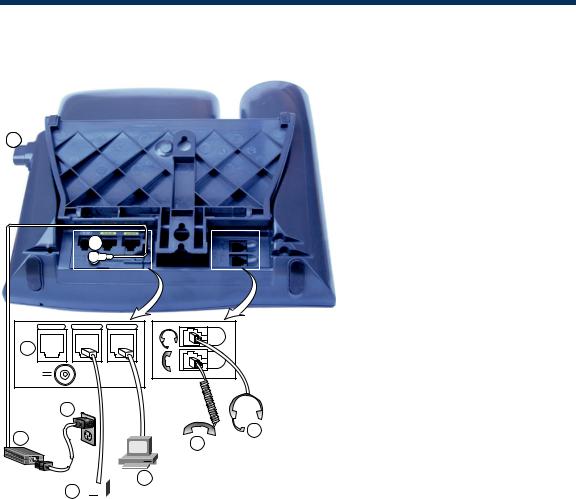
Connecting Your Phone
Your system administrator will likely connect your new Cisco Unified IP Phone to the corporate IP telephony network. If that is not the case, refer to the graphic and table below to connect your phone.
8
1
AUX |
10/100/1000 SW 10/100/1000 PC |
9 |
|
DC48V |
|
|
3 |
|
2 |
7 |
|
6 |
||
|
 5 4
5 4 
236377
1 |
DC adaptor port |
2 |
AC-to-DC power supply |
|
|
|
|
3 |
AC power cord |
4 |
Network port |
|
|
|
|
Cisco Unified IP Phone Guide for Cisco Unified Communications Manager 8.5(1) (SCCP and SIP) |
5 |
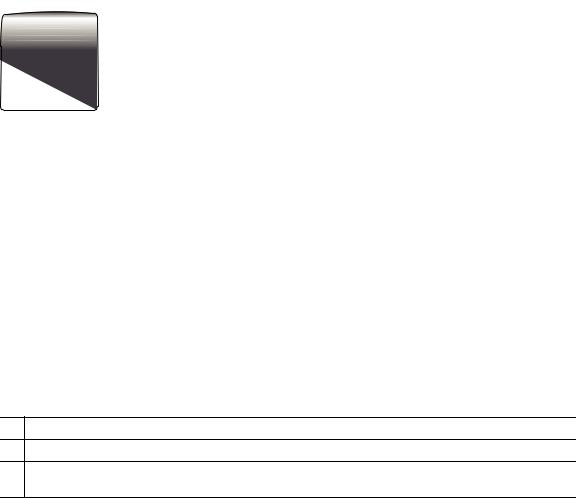
5 |
Access port |
6 |
Handset port |
|
|
|
|
7 |
Headset port |
8 |
Footstand button |
|
|
|
|
9 |
Auxiliary port |
|
|
|
|
|
|
Removing the Hookswitch Clip (Required)
Some phones ship with a clip to secure the hookswitch. Before you use your phone, remove the hookswitch clip (if present) from the cradle area. With the clip removed, the hookswitch lifts slightly when you pick up the handset.
185165
Adjusting the Handset Rest (Optional)
Cisco recommends adjusting the handset rest, particularly when wall-mounting the phones, as this will ensure that the receiver will not readily slip out of the cradle. See the table below for instructions.
1 |
2 |
3 |
77354
1Set the handset aside and pull the square plastic tab from the handset rest.
2Rotate the tab 180 degrees.
3Slide the tab back into the handset rest. An extension protrudes from the top of the rotated tab. Return the handset to the handset rest.
6 |
OL-22332-01 |

Connecting Your Phone
Adjusting the Footstand (Optional)
To change the angle of the phone base, adjust the footstand while pressing the footstand button.
Registering with TAPS
After your phone is connected to the network, your system administrator may ask you to auto-register your phone using TAPS (Tool for Auto-Registered Phones Support). TAPS may be used either for a new phone or to replace an existing phone.
To register with TAPS, pick up the handset, enter the TAPS extension provided by your system administrator, and follow the voice prompts. You may need to enter your entire extension, including the area code. After your phone displays a confirmation message, hang up. The phone will restart.
Using a Headset
You can use a wired headset with your Cisco Unified IP Phone. If you use a Cisco Unified IP Phone 7975G, 7965G, or 7945G, you can use a wireless headset in conjunction with the wireless headset remote hookswitch control feature.
Headset Support
Although Cisco Systems performs limited internal testing of third-party headsets for use with the Cisco Unified IP Phones, Cisco does not certify or support products from headset (or handset) vendors.
Cisco recommends the use of good quality external devices, for example, headsets that are screened against unwanted radio frequency (RF) and audio frequency (AF) signals. Depending on the quality of these devices and their proximity to other devices such as mobile phones and two-way radios, some audio noise or echo may still occur. An audible hum or buzz may be heard by either the remote party or by both the remote party and the Cisco Unified IP Phone user. Humming or buzzing sounds can be caused by a range of outside sources: for example, electric lights, electric motors, or large PC monitors. See Using External Devices, page 3, for more information.
Note In some cases, hum may be reduced or eliminated by using a local power cube or power injector.
These environmental and hardware inconsistencies in the locations where Cisco Unified IP Phones are deployed means that there is not a single headset solution that is optimal for all environments.
Cisco recommends that customers test headsets in their intended environment to determine performance before making a purchasing decision and deploying en masse.
Audio Quality Subjective to the User
Beyond the physical, mechanical and technical performance, the audio portion of a headset must sound good to the user and to the party on the far end. Sound quality is subjective and Cisco cannot guarantee the performance of any headsets However, a variety of headsets from leading headset manufacturers have been reported to perform well with Cisco Unified IP Phones. See manufacturer’s sites for details.
Cisco Unified IP Phone Guide for Cisco Unified Communications Manager 8.5(1) (SCCP and SIP) |
7 |
For information about wireless headsets that work in conjunction with the wireless headset remote hookswitch control feature, go to the following URL: http://www.cisco.com/pcgi-bin/ctdp/Search.pl
1.From the Enter Solution drop-down menu, choose IP Communications. The Select a Solution Category menu displays.
2.Choose IP Phone Headsets to see a list of Technology Development Program partners.
If you want to search for a particular Technology Development Program partner, enter the partner’s name in the Enter Company Name box.
8 |
OL-22332-01 |

An Overview of Your Phone
Cisco Unified IP Phones are full-feature telephones that provide voice communication over the data network that your computer uses, allowing you to place and receive phone calls, put calls on hold, transfer calls, make conference calls, and so on.
In addition to basic call-handling features, your Cisco Unified IP Phone can provide enhanced productivity features that extend your call-handling capabilities. Depending on the configuration, your phone supports:
•Access to network data, XML applications, and web-based services.
•Online customizing of phone features and services from your Cisco Unified CM User Options web pages.
•A comprehensive online help system that displays information on the phone screen.
Understanding Buttons and Hardware
To identify buttons and hardware on your phone, refer to the graphics and table below.
Cisco Unified IP Phone Guide for Cisco Unified Communications Manager 8.5(1) (SCCP and SIP) |
9 |
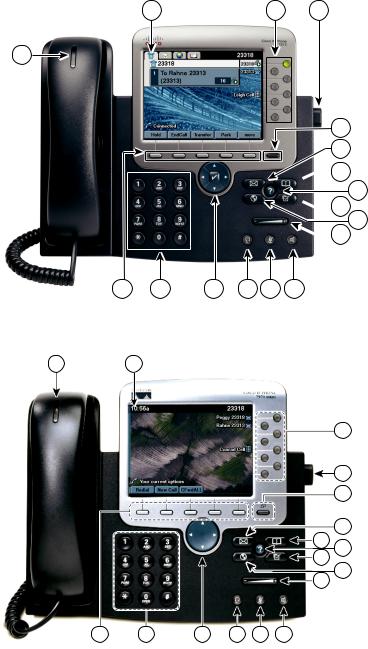
Cisco Unified IP Phone 7975G
17 |
1 |
2 |
16
3
4  5
5
 7
7
6
8
 9
9
15 |
14 |
13 |
12 |
11 |
10 |
186549 |
Cisco Unified IP Phone 7970G and 7971G-GE
16 17
15 |
14 |
13 |
12 |
11 |
10 |
1
2
3
4
5
6
7
8
9
186428
10 |
OL-22332-01 |
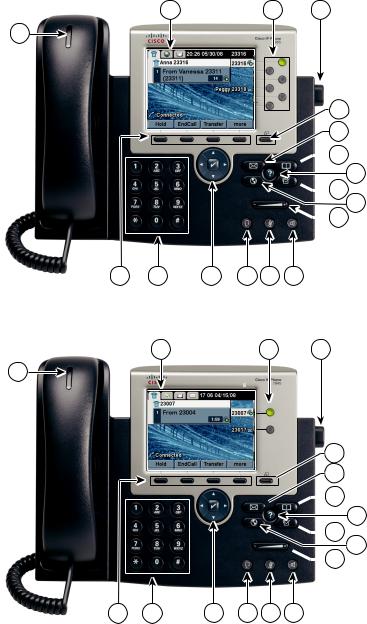
An Overview of Your Phone
Cisco Unified IP Phone 7965G
17 |
1 |
2 |
16
3
4
 5
5
6
 7
7
8
 9
9
15 |
14 |
13 |
12 |
11 |
10 |
Cisco Unified IP Phone 7945G
186422
17 |
1 |
2 |
16 |
|
|
|
1 |
|
3  4
4 
 5
5
 7
7  9
9
15 |
14 |
13 |
12 |
11 |
10 |
6
8
186421
Cisco Unified IP Phone Guide for Cisco Unified Communications Manager 8.5(1) (SCCP and SIP) |
11 |

|
Item |
Description |
For more information, see... |
|
|
|
|
|
|
1 |
Programmable |
Depending on configuration, programmable |
• |
Understanding Lines |
|
buttons |
buttons provide access to: |
|
and Calls, page 14 |
|
|
• Phone lines (line buttons) and |
• |
Basic Call Handling, |
|
|
intercom lines |
|
page 21 |
|
|
• Speed-dial numbers (speed-dial buttons, |
• Speed Dialing, page 39 |
|
|
|
including the BLF speed-dial feature) |
• Using a Shared Line, |
|
|
|
|
||
|
|
• Web-based services (for example, a |
|
page 43 |
|
|
Personal Address Book button) |
• |
Using BLF to |
|
|
|
||
|
|
• Call features (for example, a Privacy, |
|
Determine a Line State, |
|
|
Hold, or Transfer button) |
|
page 46 |
|
|
Buttons illuminate to indicate status: |
• |
Placing or Receiving |
|
|
Green, steady—Active call or |
|
Intercom Calls, page 37 |
|
|
|
|
|
|
|
two-way intercom call |
|
|
|
|
Green, flashing—Held call |
|
|
|
|
Amber, steady—Privacy in use, |
|
|
|
|
one-way intercom call, DND |
|
|
|
|
active, or logged into Hunt Group |
|
|
|
|
Amber, flashing—Incoming call or |
|
|
|
|
reverting call |
|
|
|
|
Red, steady—Remote line in use |
|
|
|
|
(shared line, BLF status or active |
|
|
|
|
Mobile Connect call) |
|
|
|
|
|
|
|
2 |
Footstand button |
Enables you to adjust the angle of the |
Adjusting the Footstand |
|
|
|
phone base. |
(Optional), page 7 |
|
|
|
|
|
|
12 |
OL-22332-01 |

|
|
|
An Overview of Your Phone |
|
|
|
|
|
|
3 |
Display button |
Cisco Unified IP Phone 7975G, 7971G-GE, |
Cleaning and Maintaining |
|
|
|
and 7970G. |
the Phone Screen, page 17 |
|
|
|
Awakens the phone screen from sleep |
|
|
|
|
mode or disables the touchscreen feature |
|
|
|
|
for cleaning. |
|
|
|
|
No color—Ready for input |
|
|
|
|
Green flashing—Disabled |
|
|
|
|
Green steady—Sleep mode |
|
|
|
|
Cisco Unified IP Phone 7965G and 7945G: |
|
|
|
|
Awakens the phone screen from |
|
|
|
|
sleep mode. |
|
|
|
|
No color—Ready for input |
|
|
|
|
Green steady—Sleep mode |
|
|
|
|
|
|
|
4 |
Messages button |
Auto-dials your voice message service (varies |
Accessing Voice Messages, |
|
|
|
by service). |
page 69 |
|
|
|
|
|
|
5 |
Directories button |
Opens/closes the Directories menu. Use it to |
Using Call Logs, page 63 |
|
|
|
access call logs and directories. |
|
|
|
|
|
|
|
6 |
Help button |
Activates the Help menu. |
Accessing the Help System |
|
|
? |
|
on Your Phone, page 19 |
|
|
|
|
|
|
7 |
Settings button |
Opens/closes the Settings menu. Use it to |
Changing Phone Settings, |
|
|
|
change phone screen and ring settings. |
page 59 |
|
|
|
|
|
|
8 |
Services button |
Opens/closes the Services menu. |
Using the User Options |
|
|
|
|
Web Pages, page 71 |
|
|
|
|
|
|
9 |
Volume button |
Controls the handset, headset, and |
Using a Handset, Headset, |
|
|
|
speakerphone volume (off-hook) and the |
and Speakerphone, page 55 |
|
|
|
ringer volume (on-hook). |
|
|
|
|
|
|
|
10 |
Speaker button |
Toggles the speakerphone on or off. When |
Using a Handset, Headset, |
|
|
|
the speakerphone is on, the button is lit. |
and Speakerphone, page 55 |
|
|
|
|
|
|
11 |
Mute button |
Toggles the microphone on or off. When the |
Using Mute, page 27 |
|
|
|
microphone is muted, the button is lit. |
|
|
|
|
|
|
|
12 |
Headset button |
Toggles the headset on or off. When the |
Using a Handset, Headset, |
|
|
|
headset is on, the button is lit. |
and Speakerphone, page 55 |
|
|
|
|
|
|
Cisco Unified IP Phone Guide for Cisco Unified Communications Manager 8.5(1) (SCCP and SIP) |
13 |
|||

13 |
4-way navigation |
Cisco Unified IP Phone 7975G, 7965G, |
|
Choosing Phone Screen |
|
pad and Select |
and 7945G: |
|
Items, page 17 |
|
button (center) |
Enables you to scroll through menus and |
|
|
|
|
|
|
|
|
|
highlight items. Use the Select button to |
|
|
|
|
select an item that is highlighted on |
|
|
|
|
the screen. |
|
|
|
|
Navigation button—Scroll up and down to |
|
|
|
|
see menus and highlight items and right and |
|
|
|
|
left across multi-column displays. |
|
|
|
|
Select button—Scroll to highlight a line using |
|
|
|
|
the Navigation button and then press |
to |
|
|
|
open a menu, play a ringer item, or access |
|
|
|
|
other features, as described on the screen. |
|
|
|
|
|
|
|
14 |
Navigation button |
Cisco Unified IP Phone 7971G-GE |
|
Using Call Logs, page 63 |
|
|
and 7970G: |
|
|
|
|
Enables you to scroll through menus and |
|
|
|
|
highlight items. When the phone is on-hook, |
|
|
|
|
displays phone numbers from your Placed |
|
|
|
|
Calls log. |
|
|
|
|
|
|
|
15 |
Keypad |
Enables you to dial phone numbers, enter |
|
Basic Call Handling, |
|
|
letters, and choose menu items. |
|
page 21 |
|
|
|
|
|
16 |
Softkey buttons |
Each activates a softkey option (displayed on |
Understanding Phone |
|
|
|
your phone screen). |
|
Screen Features, page 16 |
|
|
|
|
|
17 |
Handset light strip |
Indicates an incoming call or new |
|
Accessing Voice Messages, |
|
|
voice message. |
|
page 69 |
|
|
|
|
|
18 |
Phone screen |
Shows phone features. |
|
Understanding Phone |
|
|
|
|
Screen Features, page 16 |
|
|
|
|
|
Understanding Lines and Calls
To avoid confusion about lines and calls, refer to these descriptions:
•Lines—Each corresponds to a directory number or intercom number that others can use to call you. Your phone can support up to eight lines, depending on your phone and configuration. To see your phone lines, look at the right side of your phone screen. You have as many lines as you have directory numbers and phone line icons:  .
.
•Calls—Each line can support multiple calls. By default, your phone supports four connected calls per line, but your system administrator can adjust this number according to your needs. Only one call can be active at any time; other calls are automatically placed on hold.
14 |
OL-22332-01 |

An Overview of Your Phone
Understanding Line and Call Icons
Your phone displays icons to help you determine the line and call state.
Icon |
Line or call state |
Description |
|
|
|
|
On-hook line |
No call activity on this line. |
|
|
|
|
Off-hook line |
You are dialing a number or an outgoing call is ringing. |
|
|
|
|
Connected call |
You are connected to the other party. |
|
|
|
|
Ringing call |
A call is ringing on one of your lines. |
|
|
|
|
Call on hold |
You have put the call on hold. See Using Hold and Resume, |
|
|
page 26. |
|
|
|
|
Remote-in-use |
Another phone that shares your line has a connected call. See |
|
|
Using a Shared Line, page 43. |
|
|
|
|
Reverting call |
A holding call is reverting to your phone. See Using Hold and |
|
|
Resume, page 26. |
|
|
|
|
Authenticated call |
See Making and Receiving Secure Calls, page 47. |
|
|
|
|
Encrypted call |
See Making and Receiving Secure Calls, page 47. |
|
|
|
|
BLFmonitored line |
See Using BLF to Determine a Line State, page 46. |
|
is idle |
|
|
|
|
|
BLFmonitored line is |
See Using BLF to Determine a Line State, page 46. |
|
in-use |
|
|
|
|
|
BLFmonitored line is |
See Using BLF to Determine a Line State, page 46. |
|
ringing (BLF Pickup) |
|
|
|
|
|
Line in Do Not |
See Using BLF to Determine a Line State, page 46. |
|
Disturb (BLF feature) |
|
|
|
|
|
Idle Intercom line |
The intercom line is not in use. See Placing or Receiving Intercom |
|
|
Calls, page 37. |
|
|
|
|
One-way |
The intercom line is sending or receiving one-way audio. See |
|
intercom call |
Placing or Receiving Intercom Calls, page 37. |
|
|
|
|
Two-way |
The recipient pressed the intercom line to activate two-way audio |
|
intercom call |
with the caller. See Placing or Receiving Intercom Calls, page 37. |
|
|
|
Cisco Unified IP Phone Guide for Cisco Unified Communications Manager 8.5(1) (SCCP and SIP) |
15 |
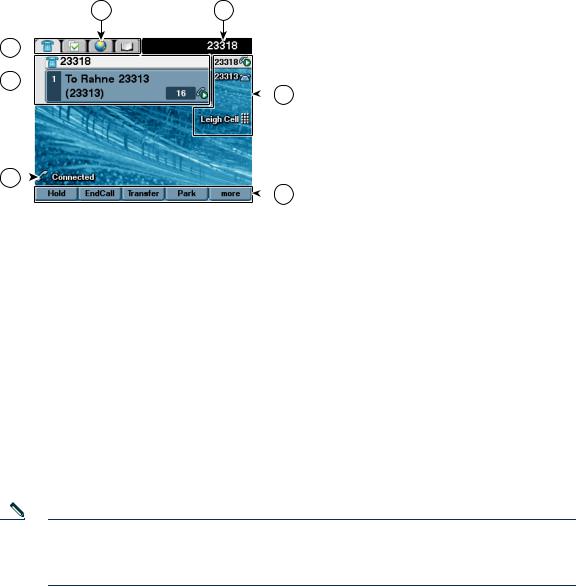
Understanding Phone Screen Features
This is what your main phone screen may look like with an active call.
7 |
1 |
6 
5 
 2
2
4 |
|
|
|
|
|
3 |
186550 |
|
|
|
|
|
|||
|
|
|
|
|
|
||
|
|
|
|
|
|
|
|
|
|
|
|
|
|
|
|
1 |
|
Primary |
Displays the phone number (directory number) for your primary phone line. |
||||
|
|
phone line |
When several feature tabs are open, the phone number and the time and date |
||||
|
|
|
|
display alternately in this area. |
|||
|
|
|
|
|
|
|
|
2 |
|
Programmable |
Serve as phone line buttons, intercom line buttons, speed-dial buttons, phone |
||||
|
|
buttons |
service buttons or phone feature buttons. Icons and labels indicate how these |
||||
|
|
|
|
buttons are configured. For an icon reference, see Phone Screen Icons, page 2. |
|||
|
|
|
|
|
|
|
|
3 |
|
Softkey labels |
Displays a softkey function for the corresponding softkey button. |
||||
|
|
|
|
|
|
|
|
4 |
|
Status line |
Displays audio mode icons, status information, and prompts. |
||||
|
|
|
|
|
|
|
|
5 |
|
Call activity area |
Displays current calls per line, including caller ID, call duration, and call state |
||||
|
|
|
|
for the highlighted line (standard view). See Understanding Line and Call |
|||
|
|
|
|
Icons, page 15, and Viewing Multiple Calls, page 29. |
|||
|
|
|
|
|
|
|
|
6 |
|
Phone tab |
Indicates call activity. |
|
|||
|
|
|
|
|
|
|
|
7 |
|
Feature tabs |
Indicates an open feature menu. See Understanding Feature Buttons and |
||||
|
|
|
|
Menus, page 18. |
|
||
|
|
|
|
|
|
|
|
Note The Messages, Directories, and Services screens on your phone may appear in Normal mode or in Wide mode depending on how your phone has been set up. A phone window in Wide mode spans the entire width of the phone screen. However, neither you nor your administrator can adjust the phone screen viewing mode.
16 |
OL-22332-01 |

An Overview of Your Phone
Choosing Phone Screen Items
There are different ways to choose items on your phone’s screen.
To choose a phone |
|
|
screen item... |
Do this... |
|
|
|
|
By touch |
Press (or tap) touch-sensitive items on the touchscreen with your fingertip. |
|
(Cisco Unified |
Use only your fingertip to press the touchscreen, as using any other objects |
|
IP Phone 7975G, |
||
could damage the display. Be aware that pressing a phone number can cause the |
||
7971G-GE, and |
||
phone to dial the number. |
||
7970G only) |
||
|
||
|
|
|
By item number |
Press the corresponding number on your keypad. For example, press 4 to |
|
|
choose the fourth item in a menu. |
|
|
|
|
By scrolling |
Use the Navigation button to highlight an item. Press the Select button to select |
|
|
the item, or a softkey to finish the action. |
|
|
|
Cleaning and Maintaining the Phone Screen
Cisco Unified IP Phone 7975G, 7971G-GE, and 7970G
Use only a soft, dry cloth to wipe the touchscreen. Do not use any liquids or powders on the phone, as they can contaminate phone components and cause failures.
Use the Display button  to disable and enable the touchscreen for cleaning. The Display button illuminates to indicate changes in touchscreen status:
to disable and enable the touchscreen for cleaning. The Display button illuminates to indicate changes in touchscreen status:
 Green, steady—Touchscreen is in sleep mode
Green, steady—Touchscreen is in sleep mode  Green, flashing—Touchscreen is disabled
Green, flashing—Touchscreen is disabled
If you want to... |
Then... |
|
|
|
|
|
|
Disable the touchscreen |
Press |
and hold for more than one second. |
flashes. |
for cleaning |
The screen remains disabled for about a minute, unless you enable it. |
||
|
|||
|
|
|
|
Enable the touchscreen |
Press |
(flashing) and hold for more than one second. |
|
(after disabling it) |
|
|
|
|
|
|
|
Wake the touchscreen |
Press the touchscreen or any button, or lift the handset. |
|
|
from sleep mode |
After a period of inactivity (determined by your system administrator), |
||
|
|||
|
the touchscreen enters sleep mode to save power. In this mode, the |
||
|
touchscreen appears blank and the Display button |
remains lit. |
|
|
|
|
|
Cisco Unified IP Phone Guide for Cisco Unified Communications Manager 8.5(1) (SCCP and SIP) |
17 |

Cisco Unified IP Phone 7965G and 7945G
Use only a soft, dry cloth to wipe the phone screen. Do not use any liquids or powders on the phone, as they can contaminate phone components and cause failures.
If you want to... |
Then... |
|
|
|
|
Wake the phone screen |
Press any button or lift the handset. |
|
from sleep mode |
After a period of inactivity (determined by your system administrator), the |
|
|
||
|
phone screen enters sleep mode to save power. In this mode, the phone |
|
|
screen appears blank and the Display button |
remains lit. |
|
|
|
Understanding Feature Buttons and Menus
Press a feature button to open or close a feature menu.
If you want to... |
Then... |
|
|
|
|
Open or close a feature |
Press a feature button: |
|
menu |
|
Messages |
|
|
|
|
|
Services |
|
? |
Help |
|
Directories |
|
|
|
|
|
|
Settings |
|
|
|
Scroll through a list |
Press the Navigation button. |
|
or menu |
|
|
|
|
|
Go back one level in a |
Press Exit. Pressing Exit from the top level of a menu closes the menu. |
|
feature menu |
|
|
|
|
|
Switch between open |
Press a feature tab. Each feature menu has a corresponding tab. The tab is |
|
feature menus |
visible when the feature menu is open. |
|
|
|
|
18 |
OL-22332-01 |

An Overview of Your Phone
Accessing the Help System on Your Phone
Your phone provides a comprehensive online help system. Help topics appear on the phone screen.
If you want to... |
Then... |
|
|
|
|
|
|
||
View the main menu |
Press |
? on your phone and wait a few seconds for the menu to display. |
||
|
Main menu topics include: |
|
||
|
• About Your Cisco Unified IP Phone—Details about your phone |
|||
|
• How do I...?—Procedures for common phone tasks |
|||
|
• Calling Features—Descriptions and procedures for calling features |
|||
|
|
|
||
Learn about a button or |
Press |
? , then quickly press a button or softkey. |
||
softkey |
|
|
|
|
|
|
|
|
|
Learn about a menu item |
Press |
, |
, or |
to display a feature menu. Highlight a |
|
menu item, then press ? |
twice quickly. |
||
Get help using Help |
Press |
? . After a second or two, press ? again, or choose Help from |
||
|
the main menu. |
|
|
|
|
|
|
|
|
Understanding Feature Availability
Depending on your phone system configuration, features included in this phone guide may not be available to you or may work differently on your phone. For additional information about feature operation or availability, contact your support desk or system administrator.
You can access many features by either using a softkey or pressing a line button. Although you can configure some features, your system administrator controls most of them.
Here are some details about using softkeys and line buttons to access features:
Feature |
Softkey |
Line Button Label and Icon |
|
||
|
|
|
|
|
|
Call Back |
CallBack |
CallBack |
|
|
|
|
|
|
|
|
|
Call Forward |
CFwdALL |
Forward All |
|
|
|
|
|
|
|
|
|
Call Park |
Park |
Park |
|
|
|
|
|
|
|
|
|
Call PickUp |
PickUp |
PickUp |
|
|
|
|
|
|
|
|
|
Conference |
Confrn |
Conference |
|
|
|
|
|
|
|
|
|
Conference List |
ConfList |
Conference List |
|
|
|
|
|
|
|
|
|
Do Not Disturb |
DND |
Do Not Disturb |
|
or |
|
|
|
Do Not Disturb |
|
|
|
|
|
|
|
|
|
|
|
|
|
|
|
End Call |
EndCall |
End Call |
|
|
|
|
|
|
|
|
|
Cisco Unified IP Phone Guide for Cisco Unified Communications Manager 8.5(1) (SCCP and SIP) |
19 |
||||

Feature |
Softkey |
Line Button Label and Icon |
||
|
|
|
|
|
Group Pickup |
GPickUp |
Group PickUp |
|
|
|
|
|
|
|
Hold |
Hold |
Hold |
|
|
|
|
|
|
|
Hunt Group |
HLog |
Hunt Group |
or |
|
|
|
Hunt Group |
|
|
|
|
|
|
|
|
|
|
|
|
Malicious Call Identification |
MCID |
Malicious Call ID |
||
|
|
|
|
|
Meet Me Conferencing |
MeetMe |
MeetMe |
|
|
|
|
|
|
|
Mobility |
Mobility |
Mobility |
|
|
|
|
|
|
|
New Call |
New Call |
New Call |
|
|
|
|
|
|
|
Other PickUp |
OPickUp |
Other PickUp |
|
|
|
|
|
|
|
Quality Reporting Tool |
QRT |
Quality Reporting Tool |
||
|
|
|
|
|
Redial |
Redial |
Redial |
|
|
|
|
|
|
|
Remove Last Conference |
RmLstC |
Remove Last Participant |
||
Party |
|
|
|
|
|
|
|
|
|
Transfer |
Transfer |
Transfer |
|
|
|
|
|
|
|
Video Support |
VidMode |
Video |
|
|
|
|
|
|
|
Understanding SIP vs. SCCP
Your phone can be configured to work with one of two signaling protocols: SIP (Session Initiation Protocol) or SCCP (Skinny Call Control Protocol). Your system administrator determines this configuration.
Phone features can vary depending on the protocol. This Phone Guide indicates which features are protocol-specific. To learn which protocol your phone is using, you can ask your system administrator or you can choose  > Model Information > Call Control Protocol on your phone.
> Model Information > Call Control Protocol on your phone.
20 |
OL-22332-01 |

Basic Call Handling
You can perform basic call-handling tasks using a range of features and services. Feature availability can vary; see your system administrator for more information.
Placing a Call—Basic Options
Here are some easy ways to place a call on your Cisco Unified IP Phone.
|
|
|
|
|
For more information, |
If you want to... |
Then... |
|
|
see... |
|
|
|
|
|||
Place a call using the handset |
Pick up the handset and enter a number. |
An Overview of Your |
|||
|
|
|
|
|
Phone, page 9 |
|
|
|
|
||
Place a call using the |
Press |
and enter a number. |
Using a Handset, |
||
speakerphone |
|
|
|
|
Headset, and |
|
|
|
|
|
Speakerphone, page 55 |
|
|
|
|
||
Place a call using a headset |
Press |
and enter a number. Or, if |
Using a Handset, |
||
|
is lit, press New Call and enter a number. |
Headset, and |
|||
|
|
|
|
|
Speakerphone, page 55 |
|
|
|
|||
Redial a number |
Press Redial to dial the last number, or |
Using Call Logs, page 63 |
|||
|
press the Navigation button (with the |
|
|||
|
phone idle) to see your Placed Calls. |
|
|||
|
|
|
|
|
|
Place a call while another call |
1. |
Press Hold. |
|
Using Hold and Resume, |
|
is active (using the same line) |
2. |
Press New Call. |
|
page 26 |
|
|
|
|
|||
|
3. |
Enter a number. |
|
|
|
|
|
|
|
|
|
Dial from a call log |
1. |
Choose |
> Missed Calls, |
Using Call Logs, page 63 |
|
|
|
Received Calls, or Placed Calls. |
|
||
|
2. |
Select the listing or scroll to it and go |
|
||
|
|
off-hook. |
|
|
|
|
|
|
|
|
|
Tips
•You can dial on-hook, without a dial tone (pre-dial). To pre-dial, enter a number, then go off-hook by lifting the handset, or pressing Dial,  , or
, or  .
.
Cisco Unified IP Phone Guide for Cisco Unified Communications Manager 8.5(1) (SCCP and SIP) |
21 |

•When you pre-dial, your phone tries to anticipate the number you are dialing by displaying matching numbers (if available) from your Placed Calls log. This is called Auto Dial. To call a number displayed with Auto Dial, press the number, or scroll to it and go off-hook.
•If you make a mistake while dialing, press << to erase digits.
•If parties on a call hear a beep tone, the call may be monitored or recorded. Ask your system administrator for more information.
•Your phone may be set up for international call logging, which is indicated by a “+” symbol on the call logs, redial, or call directory entries. See your system administrator for more information.
Placing a Call—Additional Options
You can place calls using special features and services that may be available on your phone. See your system administrator for more information about these additional options.
|
|
|
|
For more information, |
If you want to... |
Then... |
|
see... |
|
|
|
|
|
|
Place a call while another |
1. |
Press |
for a new line. The first call |
Using Hold and Resume, |
call is active (using a |
|
is automatically placed on hold. |
page 26 |
|
different line) |
2. |
Enter a number. |
|
|
|
|
|||
|
|
|
||
Speed dial a number |
Do one of these: |
Speed Dialing, page 39 |
||
|
• |
Press |
(a speed-dial button). |
|
|
• |
Use the Abbreviated Dial feature. |
|
|
|
• |
Use the Fast Dial feature. |
|
|
|
|
|
|
|
Dial from a corporate |
1. |
Choose |
> Corporate |
Using Call Logs, page 63 |
directory on your phone |
|
Directory (name can vary). |
|
|
|
2. |
Enter a name and press Search. |
|
|
|
3. |
Highlight a listing and go off-hook. |
|
|
|
|
|
|
|
Dial from a corporate |
1. |
Open a web browser and go to |
Setting Up Phones and |
|
directory on your personal |
|
a WebDialer-enabled |
Access Lists for Mobile |
|
computer using |
|
corporate directory. |
Connect, page 79 |
|
Cisco WebDialer |
2. |
Click the number that you want |
|
|
|
|
|||
|
|
to dial. |
|
|
|
|
|
|
|
22 |
OL-22332-01 |

|
|
|
|
Basic Call Handling |
|
|
|
|
|
|
|
|
|
|
|
For more information, |
|
If you want to... |
Then... |
|
see... |
|
|
|
|
|
|
|
|
Use CallBack to receive |
1. |
Press CallBack while listening to the |
Your system |
|
|
notification when a busy or |
|
busy tone or ring sound. |
administrator |
|
|
ringing extension is available |
2. |
Hang up. Your phone alerts you |
|
|
|
|
|
|
|||
|
|
when the line is free. |
|
|
|
|
3. |
Place the call again. |
|
|
|
|
Note The CallBack feature is disabled |
|
|
||
|
|
on a Call Chaperone user’s Cisco |
|
|
|
|
|
Unified IP Phone when the calls |
|
|
|
|
|
are being chaperoned. |
|
|
|
|
|
|
|||
See if a line associated with a |
Look for Busy Line Feature indicators. |
Using BLF to Determine a |
|||
speed-dial, call record, or |
|
|
|
Line State, page 46 |
|
directory listing is busy before |
|
|
|
|
|
placing a call to that line |
|
|
|
|
|
|
|
|
|||
Make a priority (precedence) |
Enter the MLPP access number and then |
Prioritizing Critical Calls, |
|||
call (SCCP phones only) |
enter a phone number. |
page 49 |
|
||
|
|
|
|
|
|
Dial from a Personal Address |
1. |
Choose |
> Personal |
Using Personal Directory |
|
Book (PAB) entry |
|
Directory to log in. |
on Your Phone, page 66 |
|
|
|
2. |
Choose Personal Address Book and |
|
|
|
|
|
search for a listing. |
|
|
|
|
|
|
|
|
|
Place a call using a billing or |
1. |
Dial a number. |
|
Your system |
|
tracking code |
2. |
After the tone, enter a client matter |
administrator |
|
|
(SCCP phones only) |
|
|
|||
|
code (CMC) or a forced |
|
|
||
|
|
|
|
||
|
|
authorization code (FAC). |
|
|
|
|
|
|
|
||
Place a call using your |
Log in to the Extension Mobility service |
Using Cisco Extension |
|
||
Extension Mobility profile |
on a phone. |
|
Mobility, page 50 |
|
|
|
|
|
|
|
|
Make a call from a mobile |
1. |
Obtain your Mobile Voice Access |
Managing Business Calls |
|
|
phone using Mobile |
|
number and end-user PIN from your |
Using a Single Phone |
|
|
Voice Access |
|
system administrator. |
Number, page 52 |
|
|
|
2. |
Dial your assigned Mobile Voice |
|
|
|
|
|
access number. |
|
|
|
|
3. |
Enter your mobile phone number, |
|
|
|
|
|
if requested, and the PIN. |
|
|
|
|
4. |
Press 1 to make a call to an |
|
|
|
|
|
enterprise IP phone. |
|
|
|
|
5. |
Dial a desktop phone number other |
|
|
|
|
|
than your desktop phone number). |
|
|
|
|
|
|
|
||
Cisco Unified IP Phone Guide for Cisco Unified Communications Manager 8.5(1) (SCCP and SIP) |
23 |
||||

|
|
For more information, |
If you want to... |
Then... |
see... |
|
|
|
Place a call using Fast Dial |
Note Before using this option, your |
Configuring Fast Dials on |
|
system administrator must |
the Web, page 73 |
|
configure this feature and assign a |
|
|
service URL to the line button. |
|
|
Contact your system administrator |
|
|
for more information. |
|
|
1. Press the Fast Dial line button. |
|
|
2. To find and select an entry, scroll to |
|
|
or press the index number. |
|
|
The system dials the specified number. |
|
|
|
|
Place a call using your PAB |
Note Before using this option, your |
Using Your Personal |
|
system administrator must |
Address Book on the |
|
configure this feature and assign a |
Web, page 72 |
|
service URL to the line button. |
|
|
Contact your system administrator |
|
|
for more information. |
|
|
1. Press the PAB line button. |
|
|
2. Access the contact and select |
|
|
the number. |
|
|
The system dials the specified number. |
|
|
|
|
Answering a Call
You can answer a call by lifting the handset, or you can use other options if they are available on your phone.
If you want to... |
Then... |
|
|
For more information, see... |
Answer with a headset |
Press |
, if unlit. Or, if |
is lit, press Using a Handset, Headset, |
|
|
Answer or |
(flashing). |
and Speakerphone, page 55 |
|
Note The ringing line is selected automatically. Contact your system administrator for the options to select the primary line each time.
If you are using a wireless headset, refer to the wireless headset documentation.
24 |
OL-22332-01 |
